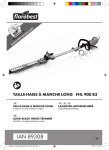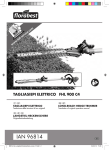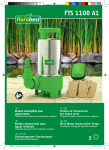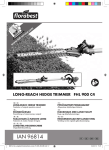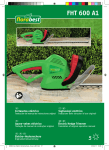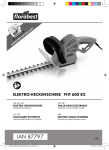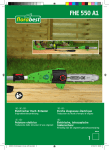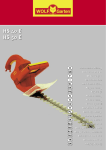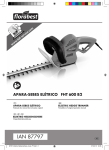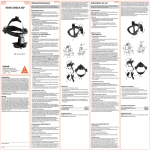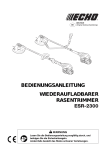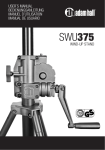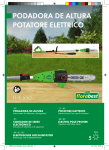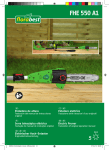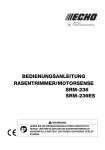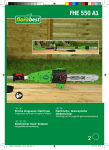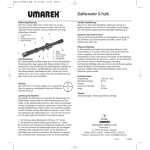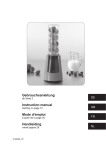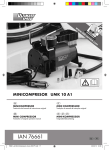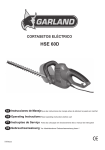Download IAN 89308 - Lidl Service Website
Transcript
® TAGLIASIEPI ELETTRICO A BRACCIO LUNGO FHL 900 B3 TAGLIASIEPI ELETTRICO A BRACCIO LUNGO LONG REACH HEDGE TRIMMER Translation of original operation manual Traduzione delle istruzioni d’uso originali LANGSTIEL-HECKENSCHERE Originalbetriebsanleitung IAN 89308 89308_Langstiel-Heckenschere_cover_IT.indd 2 28.03.13 09:43 Prima di leggere aprire la pagina con le immagini e prendere confidenza con le diverse funzioni dell’apparecchio. Before reading, unfold the page containing the illustrations and familiarise yourself with all functions of the device. Klappen Sie vor dem Lesen die Seite mit den Abbildungen aus und machen Sie sich anschließend mit allen Funktionen des Gerätes vertraut. IT / MT GB / MT DE / AT / CH Traduzione delle istruzioni d’uso originali Translation of original operation manual Originalbetriebsanleitung 89308_Langstiel-Heckenschere_cover_IT.indd 3 Pagina 5 Page 18 Seite 31 28.03.13 09:43 A B 1 19 2 1 7 4 5a 5b 6 2 7 7 8 4 5a 5b 8 ◄ 9 ► 6 7 10 18 9 17 11 12 16 15 13 14 3 4 IT Indice Introduzione ............................... 5 Utilizzo ........................................ 5 Descrizione generale .................... 6 Contenuto della confezione ............... 6 Sommario ....................................... 6 Descrizione del funzionamento .......... 6 Dati tecnici .................................. 6 Consigli di sicurezza .....................7 Simboli nelle istruzioni .....................7 Raffigurazioni sull’apparecchio ..........7 Consigli di sicurezza generali ...........8 Indicazioni di sicurezza per decespugliatori ................................8 Montaggio del Tagliasiepi a manico lungo ............................. 10 Comando .................................... 10 Orientamento della barra portalama ..11 Fissaggio tracolla ............................11 Accensione/Spegnimento ...............11 Istruzioni di lavoro .........................11 Orientamento del braccio ...............12 Tecniche di taglio ...........................12 Periodi consigliati per il taglio .........13 Lavorare in modo sicuro.............13 Manutenzione e pulizia ..............13 Magazzinaggio ..........................14 Ricambi......................................14 Smaltimento e rispetto per l’ambiente .................................14 Ricerca guasti.............................14 Garanzia ...................................15 Servizio di riparazione ...............16 Service-Center ............................17 Filiale di assistenza tecnica .........17 Traduzione della dichiarazione di conformità CE originale ..........45 Vista esplosa .............................49 MT Introduzione Congratulazioni per l’acquisto del Suo nuovo apparecchio. Ha scelto un prodotto altamente pregiato. Le istruzioni per l’uso costituiscono parte integrante di questo prodotto. Contengono indicazioni importanti per la sicurezza, l’uso e lo smaltimento. Prima dell’uso del prodotto, si raccomanda di familiarizzare con tutte le indicazioni di comando e di sicurezza. Usare il prodotto solo come descritto e per i campi d’impiego specificati. Conservare le istruzioni in un luogo sicuro e consegnare la documentazione in caso di cessione del prodotto a terzi. Utilizzo L’apparecchio è destinato esclusivamente al taglio di siepi, cespugli e mazzi decorativi in ambiente domestico. Ogni altro utilizzo non espressamente concesso nelle presenti istruzioni può causare danni all’apparecchio e costituire un pericolo reale per l’utilizzatore. L’apparecchio è destinato all’uso da parte di persone adulte. I giovani al di sopra dei 16 anni potranno utilizzare l’apparecchio solo sotto sorveglianza di un adulto. Non utilizzare il tagliasiepi quando piove o in caso di siepi bagnate. L’operatore o utilizzatore è responsabile per danni e incidenti a persone o cose. Il produttore non sarà responsabile per danni causati da un utilizzo non conforme alle presenti istruzioni o per un utilizzo improprio. Non utilizare il tagliasiepi si el dispositivo di taglio è rovinato. Fare afffilare i denti di taglio. Una lama usurata può sovracarricare l’apparecchio. 5 IT MT Descrizione generale Contenuto della Confezione - Tagliasiepi a manico lungo ( a due parti) Protezione lama Protezione gambe Tracolla Impugnatura circolare Chiave inbus Accessori di montaggio Istruzioni per l’uso - Le immagini si trovano sulla parte anteriore dell’apertura ribaltabile. Sommario A 1 2 3 4 5a 5b 6 7 8 9 10 11 12 13 14 15 16 17 18 19 C 6 Profilo con lama di sicurezza Scatola di trasmissione Fori di lubrificazione Fissaggio leva a scatto Leva a scatto Leva di bloccaggio Impugnatura per la regolazione della barra portalama Braccio anteriore Pulsante di bloccaggio Stella rotante Impugnatura circolare Corsoio di sicurezza Interruttore di sicurezza Interruttore di accensione / spegnimento Sostegno cavi Cavo di rete Tracolla Occhiello per tracolla Protezione gambe Protezione lama 20 Testa quadra 21 Viti 22 Blocco di montaggio Descrizione del funzionamento La tagliasiepi elettrico è dotata di motore elettrico. L’apparecchio dispone di isolamento di sicurezza e non necessita di messa a terra. Come dispositivo di taglio, il tagliasiepi possiede un profilo con lama di sicurezza su entrambi i lati. Durante il procedimento di taglio, i denti di taglio della lama si muovono in modo lineare avanti e indietro. La protezione anti-contraccolpo alla punta del profilo della lama evita spiacevoli contraccolpi in caso di urti contro pareti, recinti, ecc. Per motivi di protezione per l’utente, l’apparecchio può essere azionato soltanto tenendo premuto l’interruttore di sicurezza. Oltre a ciò, la protezione per le mani protegge da rami e nodi. La funzione delle varie parti è contenuta nelle descrizioni seguenti. Dati tecnici Tagliasiepi a manico lungo ...................................... FHL 900 B3 Tensione nominale in ingresso..................... ................................... 230-240V~, 50 Hz Potenza assorbita ........................... 900 W Classe di protezione ........................... II Tipo di protezione ............................ IP 20 Peso ............................................ 5,90 kg Lunghezza di taglio ...................... 410 mm Distanza tra i denti ..........................20 mm Livello di pressione acustica (LpA) ...........................................89,2 dB (A) ...................................KpA = 1,11 dB(A) Livello di potenza sonora misurata (LwA) ......................95,63 dB(A) .................................. KwA = 1,11 dB(A) Livello di potenza sonora garantito .................................. 97 dB (A) Vibrazione all’impugnatura ......................... 7,096 m/s2; K = 1,5 m/s2 Vibrazione all‘impugnatura circolare ......................... 5,862 m/s2; K = 1,5 m/s2 IT Il valore di emissione di vibrazioni indicato è stato misurato attraverso un procedimento di controllo standardizzato e può essere utilizzato per il confronto di un apparecchio elettrico con un altro. Il valore di emissione di vibrazioni indicato può essere anche utilizzato per una prima valutazione dell’esposizione alla quale si è soggetti. Avvertenza: Durante l’uso effettivo dell’apparecchio elettrico, il livello di emissione di vibrazioni può differire da quello indicato a seconda della tipologia e della modalità d’uso. Per proteggere l’utilizzatore, è necessario stabilire alcune misure di sicurezza sulla base dei valori d’esposizione alla quale si è sottoposti durante l’uso effettivo dell’apparecchio (qui bisogna considerare tutte le fasi del ciclo di lavoro, ad esempio i periodi in cui l’apparecchio è spento e quelli in cui invece è acceso, ma senza sottoporre la macchina a carico). Simboli nelle istruzioni Simboli dei pericoli con apposite indicazioni per prevenire danni a persone o cose. Simboli dei divieti (al posto del punto esclamativo, viene spiegato il divieto) con indicazioni relative alla prevenzione di danni. Simboli di avvertenza con informazioni relative ad un migliore trattamento dell’apparecchio. Raffigurazioni sull’apparecchio Attenzione! Prima dell’uso dell’apparecchio, leggere attentamente e interamente le istruzioni per l’uso. Indossare dispositivi di protezione individuale. Indossare sempre occhiali di protezione o meglio ancora una protezione del viso, protezione dell’udito, casco di protezione, indumenti di lavoro a prova di taglio, guanti a prova di taglio e stivali a prova di taglio con suole antisdrucciolevoli. I valori di rumorosità e vibrazione sono stati determinati conformemente alle prescrizioni e norme citate nella dichiarazione di conformità. Ci si riserva il diritto di apportare variazioni tecniche ed ottiche senza preavviso nell’ambito dello sviluppo del prodotto. Tutte le dimensioni, indicazioni e dati delle presenti istruzioni per l’uso sono pertanto non vincolanti. Non si accetta pertanto alcuna rivendicazione di diritti a fronte delle presenti istruzioni per l’uso. Tenere lontani i passanti dall’apparecchio Non utilizzare il tagliasiepi quando piove o in caso di siepi bagnate. Consigli di sicurezza Questa sezione tratta le norme di sicurezza essenziali da rispettare quando si lavora con l’apparecchio. MT 10 m Pericolo di vita a causa di scosse elettriche! Mantenere una distanza di minimo 10m dai cavi di tensione sospesi. Attenzione! Caduta oggetti. In particolare durante il taglio ad un altezza sopra la testa. 7 IT MT Attenzione! Pericolo di lesioni a causa di lame in movimento. Indicazioni di sicurezza generali per utensili elettrici ATTENZIONE! Leggere tutte le indicazioni di sicurezza e le istruzioni. La mancata osservanza delle indicazioni di sicurezza e delle istruzioni possono provocare scosse elettriche, incendi e/o lesioni gravi. Staccare immediatamente la spina se il cavo è danneggiato, attorcigliato o se viene tagliato e se l’apparecchio viene lasciato senza sorveglianza anche solo per breve durata. Attenzione! Superficie calda. Pericolo di ustioni. Conservare tutte le indicazioni di sicurezza e le istruzioni per una consultazione futura. Le apparecchiature non si devono smaltire insieme ai rifiuti domestici. Il termine usato nelle indicazioni di sicurezza „Utensile elettrico“ si riferisce a utensili elettrici azionati con tensione di rete (con cavo di rete) e a utensili elettrici azionati con accumulatori (senza cavo di rete). Classe di protezione II Sicurezza sul posto di lavoro: Dati del livello di rumorosità LWA in dB. Lunghezza di taglio • Consigli di sicurezza generali Prima di lavorare con l’apparecchio, acquisire dimestichezza con tutti i suoi componenti. Esercitarsi nella gestione dell’apparecchio e farsi spiegare le funzioni, effetti e tecniche di lavoro da un utente esperto o da un tecnico. Accertarsi di essere in grado, in caso di emergenza, di spegnere l’apparecchio immediatamente. L’uso non corretto dell’apparecchio può causare ferite anche molto gravi. In caso di incidente o guasto durante il funzionamento si deve spegnere immediatamente l’apparecchio e staccare la spina. Medicare le ferite secondo le disposizioni oppure recarsi da un medico. Per l’eliminazione di guasti, leggere il capitolo “Ricerca errori” oppure contattare il nostro centro di assistenza tecnica. 8 • • Tenere la zona di lavoro sempre pulita e ben illuminata. Disordine o zone di lavoro non illuminate possono causare infortuni. Non lavorare con l’utensile elettrico in ambienti a rischio di esplosioni, nei quali si trovano liquidi, gas o polveri infiammabili. Utensili elettrici generano scintille che potrebbero infiammare la polvere o i vapori. Tenere lontani bambini e altre persone durante l’uso dell’utensile elettrico. Se si viene distratti, è possibile perdere il controllo dell’apparecchio. Sicurezza elettrica: Attenzione: in questo modo si evitano infortuni e lesioni a causa di scosse elettriche: • La spina di connessione della sega elettrica a catena deve essere adatto alla la IT • • • • • • presa. La spina non deve essere manomessa in nessun modo. Non usare adattatori in combinazione con utensili elettrici collegati a massa. Spine non modificate e prese idonee ridono il rischio di scosse elettriche. Evitare il contatto del corpo con le superfici collegate a massa e con tubature, riscaldamenti, fornelli e frigoriferi. Quando il corpo è collegato a massa, aumenta il rischio di scosse elettriche. Tenere lontano l’utensile elettrico dalla pioggia e dall’umidità. L’infiltrazione d’acqua in un utensile elettrico aumenta il rischio di scosse elettriche. Non usare il cavo per trasportare o appendere l’utensile elettrico oppure per staccare la spina dalla presa. Tenere lontano il cavo da fonti di calore, olio, spigoli vivi o parti mobili dell’apparecchio. Cavi danneggiati o aggrovigliati aumentano il rischio di scosse elettriche. Quando si lavora con l’utensile elettrico all’aperto, usare solo prolunghe adatte all’uso esterno. L’impiego di una prolunga adatta all’uso esterno riduce il rischio di scosse elettriche. Quando non è possibile evitare d’impiego della sega elettrica in ambienti umidi, usare un interruttore di sicurezza per correnti di guasto. L’impiego di un interruttore di sicurezza per correnti di guasto riduce il rischio di scosse elettriche Se possibile collegare l’apparecchio esclusivamente a una presa dotata di dispositivo di protezione da corrente di guasto (interruttore FI) avente una corrente misurata non inferiore a 30 mA. • MT Nel caso in cui la conduttura di collegamento di questo apparecchio venga danneggiata, deve essere sostituita da parte del produttore o dal servizio di assistenza cliente dello stesso oppure da una persona qualificata, al fine di evitare pericoli. Sicurezza delle persone: Attenzione: in questo modo si impediscono infortuni e lesioni: • • • • Usare la massima prudenza, prestare la massima attenzione ai propri movimenti e affrontare il lavoro con la sega elettrica con raziocinio. Non usare la sega elettrica, quando si è stanchi o sotto l’effetto di droghe, alcol o farmaci. Un attimo di disattenzione durante l’uso della sega elettrica può causare lesioni gravi. Indossare l’attrezzatura di protezione personale e sempre occhiali di protezione. Indossando un’attrezzatura di protezione personale, come scarpe di sicurezza antiscivolo, elmetto o protezione per l’udito si riduce il rischio di lesioni. Evitare una messa in esercizio incustodita. Assicurarsi che la sega elettrica sia spenta prima di allacciarla all’alimentazione, afferrarla o trasportarla. Se si tiene il dito sull’interruttore durante il trasporto dell’utensile elettrico, oppure si allaccia l’apparecchio acceso all’alimentazione, si possono verificare infortuni. Rimuovere gli utensili di regolazione o chiave per dadi, prima di accendere la sega elettrica. Un utensile o una chiave che si trova all’interno di una parte rotante dell’apparecchio, può causare lesioni. 9 IT • • MT Evitare una postura anormale. Garantire una posizione stabile e mantenere l’equilibrio in ogni momento. In questo modo è possibile controllare meglio la sega elettrica nelle situazioni impreviste. Indossare un abbigliamento idoneo. Non indossare vestiti larghi o gioielli. Tenere lontani capelli, capi di abbigliamento e guanti dalle parti in movimento. Capi di abbigliamento larghi, gioielli o capelli lunghi possono essere prelevati dalle parti in movimento. • • Utilizzo e manutenzione dell’utensile elettrico: • • • • 10 Non sovraccaricare l’apparecchio. Usare gli utensili elettrici adatti per il tipo di lavoro. Con l’utensile elettrico adatto si lavora in modo migliore e più sicuro nell’ambito del campo di potenza specificato. Non usare utensili elettrici con l’interruttore difettoso. Un utensile elettrico che non può più essere acceso o spento è pericoloso e deve essere riparato. Staccare la spina dalla presa prima di eseguire le regolazioni dell’apparecchio, sostituire gli accessori o deporre l’apparecchio. Queste misure sono atte a impedire l’avviamento involontario della sega elettrica. Tenere l’utensile elettrico inutilizzato fuori dalla portata di bambini. Non consentire l’uso dell’apparecchio a persone che non hanno familiarizzato con lo stesso o non hanno letto le istruzioni. Gli apparecchi elettrico sono pericolosi se usati da persone inesperte. • • • Trattare l’utensile elettrico con cura. Controllare che le parti in movimento funzionino perfettamente e non si inceppino, che i componenti non siano spezzati o danneggiati, che il funzionamento della sega elettrica non sia compromesso. Fare riparare i componenti danneggiati prima dell’impiego dell’apparecchio. Molti infortuni sono causati da una manutenzione non corretta degli utensili elettrici. Tenere gli utensili da taglio affilati e puliti. Utensili da taglio con spigoli da taglio affilati si inceppano meno frequentemente e sono più facili da gestire. Usare la sega elettrica, gli accessori, gli utensili ecc. conformemente alle presenti istruzioni. Tenere conto delle condizioni di lavoro e dell’attività da svolgere. L’uso dell’utensile elettrico per scopi diversi da quelli previsti può generare situazioni pericolose. Prima di iniziare il lavoro ispezionare la siepe e rimuovere eventuali oggetti nascosti, come p. es. fili metallici ecc. Tenere l’apparecchio elettrico solo per le superfici di presa isolate, in quanto la lama da taglio può venire a contatto con condutture elettriche nascoste o con il suo stesso cavo di alimentazione. Il contatto della lama di taglio con una conduttura conduttiva può mettere sotto tensione le parti metalliche dell’apparecchio causare scosse elettriche. Assistenza tecnica: • Fare riparare l’utensile elettrico solo da personale specializzato qualificato e solo con i ricambi originali. In questo modo si garantisce il mantenimento della sicurezza dell’utensile elettrico. IT Indicazioni di sicurezza per decespugliatori: • • • Tenere tutte le parti del corpo lontane dalla lama da taglio. Non cercare di rimuovere il materiale tagliato o tenere fermo il materiale da tagliare con la lama in movimento. Rimuovere il materiale tagliato solo con l’apparecchio spento. Un attimo di disattenzione durante l’uso del decespugliatore può provocare lesioni gravi. Trasportare il decespugliatore dal manico con la lama ferma. Durante il trasporto e lo stoccaggio del decespugliatore mettere sempre la copertura di protezione. Un uso prudente dell’apparecchio riduce i rischi di lesioni a causa della lama. Tenere il cavo lontano dalla zona di taglio. Durante il lavoro può verificarsi che il cavo sia nascosto nel cespuglio e venga quindi tagliato. Montaggio del Tagliasiepi a manico lungo Prima di fare qualunque lavoro all’apparecchio, staccare sempre la spina di alimentazione. Utilizzare solo ricambi originali. B 1. Aprire la confezione dell’apparecchio e verificare che questo sia completo. 2. Inserire il braccio anteriore (7) del tagliasiepi a manico lungo sull’estremità del tubo del tagliasiepi a manico lungo mediante un lieve movimento rotatorio. Il pulsante di bloccaggio (8) scatta in posizione. Fissare i due C MT elementi del tubo con la stella girevole (9). A tale proposito, avvitare il dado dell’asta filettata della stella girevole (9) e inserirla lateralmente nella sede dell’estremità del tubo. Introdurre l’asta filettata con la stella girevole (9) nell’estremità del tubo e avvitare la stella girevole (9) con il dado. 3. Montare la protezione delle gambe per destri nella variante a). Per mancini, montare la protezione delle gambe in posizione invertita nella variante b) conformemente alla figura. Inserire i quattro dadi a testa quadra (20) nel protezione gambe (17). Inserire la protezione delle gambe a scelta nella posizione a) o b) sul blocco di montaggio (22). Infilare le viti (21) nei fori allineati e avvitare la protezione delle gambe con il blocco di montaggio, fino a quando è saldamente fissato. Comando Non utilizzare l’apparecchio senza protezione mani. Durante il lavoro con questo apparecchio, indossare abiti adeguati e guanti da lavoro. Prima di ogni utilizzo accertarsi che l’apparecchio sia funzionante. Non bloccare l’interruttore di accensione/ spegnimento né quello di sicurezza. Essi devono spegnere il motore dopo il rilascio dell’interruttore. Qualora un interruttore sia danneggiato, è vietato continuare a lavorare. Prestare attenzione al fatto che la tensione di rete coincida con l’etichetta del tipo riportata sull’apparecchio. 11 IT MT Rispettare le normative sulla rumorosità e quelle locali. L’utilizzo di questo apparecchio potrà essere limitato o vietato in determinati giorni (ad es. la domenica e i festivi) durante determinati orari della giornata (nelle ore centrali della giornata e di notte) o in determinati ambiti (es. luoghi di cura, cliniche ecc.). Orientamento della barra portalama Fissaggio tracolla Fissare il moschettone della tracolla ( A 15) all’occhiello di supporto ( A 16) posto sul corpo del tubo dell’apparecchio. Scegliere la lunghezza della cintura in modo tale che il moschettone della tracolla si trovi circa all’altezza dell‘anca. Accensione/Spegnimento Avere l’accortezza di assumere una posizione stabile e mantenere l’apparecchio saldamente con entrambe le mani e ad una certa distanza dal proprio corpo. Prima di accendere l’apparecchio, prestare attenzione che esso non sia a contatto con altri oggetti. D 1. 2. 3. 4. 5. Tenere il profilo con lama di sicurezza ( A 1) sull’impugnatura per la regolazione della barra portalama (6). Svitare il fissaggio della leva a scatto (4) dalla leva a scatto (5a). Sbloccare la leva a scatto (5a) premendo la leva di bloccaggio (5b). Premendo contemporaneamente la leva di bloccaggio (5b) e la leva a scatto (5a) si allenta il profilo con lama di sicurezza ( A 1). Ora è possibile orientare il profilo per lama di sicurezza ( A 1) in posizione d’esercizio. Usare la manopola a scatti e ribloccare la leva a scatto (5a) e la leva di bloccaggio (5b). Riavvitare il fissaggio della leva a scatto (4) nella leva a scatto (5a). La barra di lame ritratta è una posizione per il trasporto e lo stoccaggio. Per lavorare con l’apparecchio la barra di lame può essere estratta fino a massimo 90° 1. Formare con l’estremità della prolunga un cappio e appenderlo nello scarico ( A 14) della trazione alla fine dell’alloggiamento dell‘apparecchio. 2. Collegare l’apparecchio alla tensione di alimentazione. 3. Per accendere, tenere premuto l’interruttore di sicurezza ( A 12) e premere contemporaneamente l’interruttore di accensione/spegnimento ( A 13). L’apparecchio va a velocità massima. 4. Quando rilasciate l’interruttore di accensione/spegnimento ( A 13), l’apparecchio si spegne. Istruzioni di lavoro Durante il taglio, prestare attenzione non entrare in contatto con pali o fili di recinzione né con pali di supporto per piante. Ciò potrebbe causare danni al profilo con lama. • 12 Tenere l’apparecchio sempre saldamente con due mani, con una mano sull’impu- IT • • • gnatura posteriore e con l’altra sull’impugnatura anteriore. Il pollice e le dita devono afferrare saldamente le impugnature. In caso di blocco della lama a causa di oggetti duri, spegnere immediatamente l’apparecchio, staccare la spina e eliminare l’ostacolo. Lavorare con l’apparecchio sempre in direzione opposta alla presa di corrente. Per tale ragione, prima di iniziare a lavorare con l’apparecchio, stabilire la direzione di taglio. Accertarsi che il cavo sia lontano dalla zona in cui si effettuano le operazioni di taglio. Non poggiare mai il cavo sulla siepe, potrebbe essere facilmente danneggiato dalle lame in movimento. Evitare di sollecitare troppo l’apparecchio durante il lavoro. Staccare immediatamente la spina se il cavo è danneggiato, attorcigliato o se viene tagliato. Orientamento del braccio Attenzione ! La scatola di trasmissione ( A 2) si surriscalda durante l’esercizio. Pericolo di ustioni. Non toccare la scatola di trasmissione (A2) e il punto di collegamento con il braccio anteriore (A7). E 1. Sbloccare il dispositivo di scatto mediante avanzamento del corsoio di sicurezza (11). 2. Ora è possibile girare il corpo del tubo di 45° / 90° a scelta verso destra o verso sinistra (vedi scala sull’apparecchio). MT Tecniche di taglio • • • • • Prima di tutto tagliare i rami grossi con una forbice per rami. Il profilo con lama bilaterale rende possibile il taglio in entrambe le direzioni o con movimenti a pendolo da un lato all’altro. In caso di taglio verticale, muovere il tagliasiepi in modo omogeneo in avanti oppure a forma di arco in avanti e indietro. In caso di taglio orizzontale, muovere il tagliasiepi in direzione verso il bordo della siepe, in modo che i rami tagliati cadano a terra. Per ottenere linee lunghe e diritte, si consiglia di tendere un filo. Per tagliare le siepi a formato: Si consiglia di tagliare le siepi a forma trapezoidale per evitare uno spoglio dei rami inferiori. Ciò corrisponde alla crescita naturale della pianta e consente alla siepe di attecchire in modo ottimale. Durante il taglio vengono ridotti solo i nuovi getti annuali in modo da formare una fitta ramificazione e un buona protezione visiva. 1. Tagliare prima di tutto i lati di una siepe. A tale scopo muovere la tagliasiepi per siepi dal basso verso l’alto in direzione della crescita. Se si esegue il taglio dall’alto verso il basso, i rami più sottili si spostano all’esterno causando punti radi o addirittura aperture. 2. A questo punto tagliare il margine superiore a piacere, dando una forma diritta, a spiovente o rotonda. 3. Tosare le piante giovani nella forma desiderata. Il getto principale deve rimanere integro fino a quando la siepe ha raggiunto l’altezza prevista. Tutti gli altri getti vengono potati a metà. 13 IT MT Per la cura delle siepi a crescita libera: Le siepi che crescono liberamente non vengono tagliate a formato, tuttavia necessitano di essere curate regolarmente affinché non diventino troppo alte. Periodi consigliati per il taglio Siepi di piante latifoglie: in giugno e ottobre Siepi di boschetti aghiformi: aprile e agosto Siepi di conifere sempreverdi: a partire da maggio Lavorare in modo sicuro Osservare gli angoli di lavoro prescritti (vedi figura in alto), per garantire un modo di lavorare sicuro. Non usare il deramificatore su una scala o una posizione non sicura. Non lasciatevi tentare di fare un taglio non ben ragionato. Potreste mettere a rischio l’integrità vostra e di altre persone. Bambini devono essere sorvegliati per garantire che non giochino con l’apparecchio. Manutenzione e pulizia Fare eseguire al nostro servizio di assistenza tutte le operazioni di riparazione e di manutenzione che non sono indicate in queste istruzioni per l’uso. Utilizzare solo parti originali. Prima di fare qualunque lavoro all’apparecchio, staccare sempre la spina di alimentazione. 14 Indossare i guanti durante la manipolazione delle lame. Eseguire regolarmente le seguenti operazioni di manutenzione e pulizia. In questo modo si garantisce un utilizzo affidabile e duraturo. • Prima di ogni utilizzo controllare che la tagliasiepi per siepi sia priva di difetti visibili, quali parti lente, usurate o danneggiate. Controllare che le viti siano saldamente fissate nel profilo con lama. • Non eseguire operazioni di taglio con lame consumate o non affilate, perché altrimenti vengono sovraccaricati il motore e gli ingranaggi dell’apparecchio. • Verificare che le coperture e le protezioni non siano danneggiate e che siano fissate correttamente. Eventualmente, sostituirle. • Tenere pulite le fessure di ventilazione e l’alloggiamento del motore dell’apparecchiatura. A tale scopo, utilizzare un panno umido o uno scovolino. L’apparecchiatura non deve essere lavata con getto d’acqua né immersa in acqua. • Non utilizzare soluzioni detergenti. Esse potrebbero danneggiare l’apparecchiatura in modo irreparabile. Le sostanze chimiche possono penetrare nelle parti in plastica dell’apparecchiatura. • Dopo ogni utilizzo, pulire accuratamente il profilo con lame. Strofinare il profilo con uno straccio imbevuto di olio o spruzzare uno spray apposito per i metalli. • La trasmissione non richiede interventi di manutenzione. IT Magazzinaggio • Conservare le cesoie per siepi nel vano di protezione della lama contenuto nella confezione nonché lontano dalla portata dei bambini. Ricambi I pezzi di ricambio si possono ordinare presso il centro di assistenza Grizzly (Grizzly Service-Center). Specificare sull’ordine il tipo di macchina e il numero componente riportato sul disegno esploso. MT Smaltimento e rispetto per l’ambiente Effettuare lo smaltimento dell’apparecchio, degli accessori e della confezione nel rispetto dell’ambiente presso un punto di raccolta per riciclaggio. Le apparecchiature non si devono smaltire insieme ai rifiuti domestici. Consegnare l’apparecchio a un centro di riciclaggio: le parti in plastica e quelle in metallo, riutilizzate, possono essere separate le une dalle altre e quindi riutilizzate. Chiedere a tal proposito al nostro servizio di assistenza. Ricerca guasti Problema Causa possibile Soluzione Manca tensione di alimentazione Controllare la presa, il cavo, il filo, la spina, ed eventualmente far riparare a un elettricista specializzato L‘apparecchio non parte Interruttore di accensione / spegnimento difettoso Riparazione presso il servizio di assistenza Carboncini usurati Motore difettoso Il cavo di alimentazione è Controllare il cavo, eventualmente farlo sostituire dal nostro servizio di L‘apparecchiatura danneggiato assistenza funziona con Contatto interno difettoso Riparazione presso il servizio di interruzioni Interruttore di accensione assistenza / spegnimento difettoso Affilare il profilo della lama oppure farlo Lama usurata sostituire (servizio di assistenza) Controllare il profilo della lama oppure Le lame si La lama è frastagliata surriscaldano farlo sostituire (servizio di assistenza) Troppo attrito per Lubrificare il profilo con lama mancanza di lubrificante 15 IT MT Garanzia Gentile cliente, Su questo apparecchio Le viene concessa una garanzia di 3 anni a partire dalla data di acquisto. In caso di difetti di questo prodotto può avanzare diritti legali nei confronti del venditore del prodotto. Tali diritti legali non vengono limitati dalla nostra garanzia qui di seguito rappresentata. Condizioni di garanzia Il termine di garanzia inizia con la data di acquisto. La preghiamo di conservare in un luogo sicuro lo scontrino fiscale originale. Questo documento viene richiesto come prova d’acquisto. Qualora subentrasse un difetto di materiale o di fabbricazione entro tre anni a partire dalla data di acquisto di questo prodotto, il prodotto verrà riparato o sostituito – a nostra discrezione - gratuitamente da noi. Questa prestazione di garanzia presuppone che venga presentato entro il termine di tre anni l’apparecchio difettoso e la prova d’acquisto (scontrino fiscale) e descritto brevemente per iscritto in che cosa consiste il difetto e quando si è verificato. Se il difetto è coperto dalla nostra garanzia, riceverà il prodotto riparato oppure un prodotto nuovo. Con la riparazione o la sostituzione del prodotto non inizia un nuovo periodo di garanzia. Tempo di garanzia e diritti legali per vizi della cosa Il periodo di garanzia non viene prolungato. Questo vale anche per parti sostituite e riparate. Difetti e vizi presenti già al momento dell’acquisto devono essere segnalati immediatamente dopo la rimozione dall’imballaggio. Riparazioni che accorrono dopo il periodo di garanzia sono a pagamento. 16 Volume di garanzia L’apparecchio è stato prodotto accuratamente secondo severe direttive di qualità e controllato con coscienza prima della consegna. La prestazione di garanzia vale per difetti di materiale o di fabbricazione. Questa garanzia non si estende ai componenti del prodotto che sono soggetti a normale usura e che quindi possono essere visti come parti di usura (p. es. filtri o inserti) oppure per danneggiamenti delle parti fragili (p. es. interruttori, accumulatori o elementi di vetro). Questa garanzia decade se il prodotto è stato danneggiato, non usato correttamente o non manutenuto. Per un uso corretto del prodotto devono essere osservate tutte le indicazioni riportate nelle istruzioni per l’uso. Destinazioni d’uso e azioni sconsigliate nelle istruzioni d’uso o dalle quali si viene avvertiti, sono tassativamente da evitare. Il prodotto è destinato esclusivamente all’uso commerciale. In caso di uso improprio, esercizio della forza e interventi non effettuati dalla nostra filiale di assistenza tecnica autorizzata, decade la garanzia. Svolgimento in caso di garanzia Per garantire una rapida elaborazione della Sua pratica, La preghiamo di seguire le seguenti indicazioni: • per tutte le richieste tenere a portata di mano lo scontrino fiscale e il codice articolo (p. es. IAN 12345) come prova d’acquisto. • I codici articolo sono riportati sulla targhetta del tipo, sulla copertina delle istruzioni (in basso a sinistra) oppure come adesivo sulla parte posteriore o inferiore. IT • • Nel caso in cui si dovessero verificare difetti funzionali o altri vizi, La preghiamo di contattare telefonicamente o per e-mail. Riceverà ulteriori informazioni sullo svolgimento del Suo reclamo. Un prodotto rilevato come difettoso può essere inviato con porto franco all’indirizzo di assistenza comunicato, previa consultazione del nostro servizio di assistenza tecnica, allegando la prova d‘acquisto (scontrini fiscali) e l’indicazione, in che cosa consiste il difetto e quando si è verificato. Per evitare problemi di accettazione e costi aggiuntivi, usare tassativamente solo l’indirizzo che Le è stato comunicato. Assicurarsi che la spedizione non avvenga in porto assegnato, con merce ingombrante, corriere espresso o altro carico speciale. Spedire l’apparecchio inclusi tutti gli accessori forniti insieme al momento dell’acquisto e garantire un imballaggio di trasporto sufficientemente sicuro. Servizio di riparazione MT Service-Center IT Assistenza Italia Tel.: 02 36003201 E-Mail: [email protected] IAN 89308 Assistenza Malta MT Tel.: 80062230 E-Mail: [email protected] IAN 89308 Filiale di assistenza tecnica Non dimenticare che il seguente indirizzo non è un indirizzo di assistenza tecnica. Contattare prima di tutto il centro di assistenza tecnica sopra nominato. IT Garden Italia SPA Via Zaccarini, 8 29010 San Nicolò a Trebbia (PC) Grizzly Service Malta MT Fax: 0049 6078 780670 Riparazioni non soggette alla garanzia possono essere effettuate dietro fattura dalla nostra filiale di assistenza tecnica previo preventivo gratuito da parte della stessa. Possiamo lavorare solo apparecchi che vengono spediti sufficientemente imballati e affrancati. Attenzione: Spedire l’apparecchio alla nostra filiale in condizioni pulite e con l’indicazione del difetto. Apparecchi spediti in porto assegnato con merce ingombrante, corriere espresso o altro carico speciale - non vengono accettati. Lo smaltimento degli apparecchi difettosi spediti viene effettuato da noi gratuitamente. 17 GB MT Contents Introduction ...............................18 Intended use ..............................18 General description ....................19 Extent of the delivery ......................19 Overview ......................................19 Function description .......................19 Technical data ............................19 Notes on Safety ......................... 20 Symbols in the manual .................... 20 Symbols on the Equipment .............. 20 General Notes on Safety................. 21 General safety instructions for power tools ................................... 21 Hedge trimmer safety warnings.......... 23 Assembling the Long-Handled Hedge Trimmer ... 24 Operating the Hedge Trimmer ... 24 Swivelling Out the Blade Beam ........ 24 Attach the shoulder strap ................ 25 Switching On and Off .................... 25 Working with the Electric Hedge Trimmer .............................. 25 Swivelling the Arm ......................... 25 Cutting Techniques ......................... 26 Cutting Times ................................. 26 Working Safely .......................... 27 Maintenance/Cleaning ............... 27 Storage ...................................... 27 Spare Parts ................................ 27 Trouble Shooting ........................ 28 Waste Disposal and Environmental Protection .................................. 28 Guarantee ................................. 29 Repair Service ............................ 30 Service-Center ............................ 30 Service Branch ........................... 30 Translation of the original EC declaration of conformity ...... 47 Exploded Drawing ..................... 49 18 Introduction Congratulations on the purchase of your new device. With it, you have chosen a high quality product. The operating instructions constitute part of this product. They contain important information on safety, use and disposal. Before using the product, familiarise yourself with all of the operating and safety instructions. Use the product only as described and for the applications specified. Keep this manual safely and in the event that the product is passed on, hand over all documents to the third party. Intended Use The equipment is specified for use only for the cutting and trimming of hedges, bushes and ornamental shrubs in the domestic environment. Any other use that is not explicitly approved in these instructions may result in damage to the equipment and represent a serious danger to the user. The equipment is designed for use by adults. Adolescents over the age of 16 may use the device only under supervision. Do not use the hedge trimmer in the rain or on wet hedges. The operator or user is responsible for accidents or damage to other people or their property. The manufacturer is not liable for damages caused by unspecified use or incorrect operation. Before use, check that the blades are sharp. Ensure that the blades are sharpened whenever blunt, in order to avoid overstressing of the machine. Damages caused by cutting with blunt blades are not covered by the guarantee. GB General Description Extent of delivery - Long-handled hedge trimmer (two-part) Blade protection Leg protection Shoulder strap Round handle Allen wrench Instruction Manual See the front fold-out page for illustrations. Overview A 1 2 4 5a 5b 6 7 8 9 10 11 12 13 14 15 16 17 18 19 C Safety blade Gearbox Stop lever fixing Stop lever Safety lever Handle for adjusting the blade beam Front arm Safety button Pivotal centre Round handle Safety slide Deadman switch On/off switch Strain relief Mains cable Shoulder strap Eye (for shoulder strap) Leg protection Blade protection 20 Square nuts 21 Screws 22 Assembly block MT Function Description The electric hedge trimmer is driven by an electronic motor. The equipment is doubleinsulated for safety and does not require earthing. The hedge trimmer is equipped with a double-sided safety cutter bar. When cutting, the blades move backwards and forwards in linear motion. The impact protection on the tip of the cutter bar prevents unpleasant recoils should the trimmer come into contact with walls, fences and so on. The unit can only be operated with the deadman switch depressed, in order to protect the operator. In addition, the hand guard protects against branches and briars. Please note the following descriptions for the function of the operating components. Technical Data Electrical Hedge Trimmer .................................... FHL 900 B3 Input voltage rating ....230-240V~, 50 Hz Input power ................................ 900 W Safety class .................................... II Degree of protection ....................... IP 20 Weight ..................................... 5,90 kg Cutting length ........................... 410 mm Cutting capacity.......................... 20 mm Acoustic pressure level (LpA) ................89,2 dB(A); KpA = 1,11 dB(A) Measured sound power level (LwA) .............. 95,63 dB(A); KwA = 1,11 dB(A) Guaranteed sound power level ............................................ 97,0 dB(A) Vibration at the handle ...................... 7,096 m/s2; K = 1,5 m/s2 Vibration at the round handle ...................... 5,862 m/s2; K = 1,5 m/s2 19 GB MT Noise and vibration values have been determined according to the standards and regulations mentioned in the declaration of conformity. Technical and optical changes may be undertaken in the course of further development without notice. All dimensions, references and information in this instruction manual are therefore not guaranteed. Legal claims made on the basis of the instruction manual can therefore not be considered as valid. The stated vibration emission value was measured in accordance with a standard testing procedure and may be used to compare one power tool to another. The stated vibration emission value may also be used for a preliminary exposure assessment. Warning: The vibration emission value may differ during actual use of the power tool from the stated value depending on the manner in which the power tool is used. Safety precautions aimed at protecting the user should be based on estimated exposure under actual usage conditions (all parts of the operating cycle are to be considered, including, for example, times during which the power tool is turned off and times when the tool is turned on but is running idle). Symbols in the manual Warning symbols with information on damage and injury prevention. Instruction symbols (the instruction is explained at the place of the exclamation mark) with information on preventing damage. Help symbols with information on improving tool handling. Symbols on the Equipment Caution! Read through the instruction manual carefully. Wear personal protective equipment. Basically, wear protective goggles or, even better, face protection, ear protection, safety helmet, cut-protection working clothes, cutprotection gloves, and cut-protection safety boots with anti-slip soles. Keep the equipment away from nearby people. Do not use the hedge trimmer in the rain or on wet hedges. Notes on Safety This section deals with the basic safety regulations to be observed when working with the electric hedge trimmer. 10 m Danger of death by electrocution! Keep at least 10m away from power lines. Caution! Falling objects. Particularly when cutting overhead. 20 GB Caution! Risk of injury from blades in operation. General safety instructions for power tools WARNING! Read all safety directions and instructions. Omissions in the compliance with safety directions and instructions can cause electrical shock, fire and/or severe injuries. Pull out the power plug immediately if the cable is damaged, has been badly twisted or is completely cut through and in the event that the device is left unattended for a short time. Caution! Hot surface. Risk of burns. Information of the acoustic power level LWA in dB. Machines are not to be place with domestic waste. Safety class II Cutting length General Notes on Safety Before working with the equipment, familiarise yourself with all operating components. Practice handling the equipment and have the function, operation and working methods explained to you by an experienced user or specialist. Ensure that you can shut off the equipment immediately in an emergency. Inappropriate use of the device may result in serious injury. If an accident or fault occurs during operation, immediately switch off the device and disconnect at the plug. Treat injuries appropriately or consult a doctor. For the correction of faults, read the “Troubleshooting” chapter or contact our service centre. MT Retain all safety directions and instructions for future use. The term “Power Tools” used in the safety instructions refers to mains-operated power tools (with power cord) and to battery-operated power tools (without power cord). Work area safety • • • Keep work area clean and well lit. Cluttered or dark areas invite accidents. Do not operate power tools in explosive atmospheres, such as in the presence of flammable Iiquids, gases or dust. Power tools create sparks which may ignite the dust or fumes. Keep children and bystanders away while operating a power tool. Distractions can cause you to lose control. Electrical safety • Power tool plugs must match the outlet. Never modify the plug in any way. Do not use any adapter plugs with earthed (grounded) power tools. Unmodified plugs and matching outlets will reduce risk of electric shock 21 GB • • • • • • • 22 MT Avoid body contact with earthed or grounded surfaces, such as pipes, radiators, ranges and refrigerators. There is an increased risk of electric shock if your body is earthed or grounded. Do not expose power tools to rain or wet conditions. Water entering a power tool will increase the risk of electric shock. Do not abuse the cord. Never use the cord for carrying, pulling or unplugging the power tool. Keep cord away from heat, oil, sharp edges or moving parts. Damaged or entangled cords increase the risk of electric shock. When operating a power tool outdoors, use an extension cord suitable for outdoor use. Use of a cord suitable for outdoor use reduces the risk of electric shock. If operating a power tool in a damp location is unavoidable, use a residual current device (RCD) protected supply. Use of an RCD reduces the risk of electric shock. Where possible, connect the equipment only to a plug socket with a leakage-current-operated circuit breaker (FI switch), with a rated current of not more than 30 mA. If the power cable for this equipment is damaged, it must be replaced by the manufacturer, a customer service agent of the same or a similarly qualified person in order to prevent hazards. Personal safety • • • • • • Stay alert, watch what you are doing and use common sense when operating a power tool. Do not use a power tool while you are tired or under the influence of drugs, alcohol or medication. A moment of inattention white operating power tools may result in serious personal injury. Use personal protective equipment. Always wear eye protection. Protective equipment such as dust mask, non-skid safety shoes, hard hat, or hearing protection used for appropriate conditions will reduce personal injuries. Prevent unintentional starting. Ensure the switch is in the offposition before connecting to power source and/or battery pack, picking up or carrying the tool. Carrying power tools with your finger on the switch or energising power tools that have the switch on invites accidents. Remove any adjusting key or wrench before turning the power tool on. A wrench or a key left attached to a rotating part of the power tool may result in personal injury. Do not overreach. Keep proper footing and balance at all times. This enables better control of the power tool in unexpected situations. Dress properly. Do not wear loose clothing or jewellery. Keep your hair, clothing and gloves away from moving parts. Loose clothes, jewellery or long hair can be caught in moving parts. GB Power tool use and care • • • • • • Do not force the power tool. Use the correct power tool for your application. The correct power tool will do the job better and safer at the rate for which it was designed. Do not use the power tool if the switch does not turn it on and off. Any power tool that cannot be controlled with the switch is dangerous and must be repaired. Disconnect the plug from the power source and/or the battery pack from the power tool before making any adjust -ments, changing accessories, or storing power tools. Such preventive safety measures reduce the risk of starting the power tool accidentaIly. Store idle power tools out of the reach of children and do not allow persons unfamiliar with the power tool or these instructions to operate the power tool. Power tools are dangerous in the hands of untrained users. Maintain power tools. Check for misalignment or binding of moving parts, breakage of parts and any other condition that may affect the power tool’s operation. If damaged, have the power tool repaired before use. Many accidents are caused by poorly maintained power tools. Keep cutting tools sharp and clean. Properly maintained cutting tools with sharp cutting edges are less Iikely to bind and are easier to control. MT • Use the power tool, accessories and tool bits etc. in accordance with these instructions, taking into account the working conditions and the work to be performed. Use of the power tool for operations different from those intended could result in a hazardous situation. • Carefully inspect the area to be cut and remove all wires or other foreign bodies. Hold the power tool by insulated gripping surfaces only, because the cutter blade may contact hidden wiring or its own cord. • Service • Have your power tool serviced by a qualified repair person using only identical replacement parts. This will ensure that the safety of the power tool is maintained. Hedge trimmer safety warnings: • • Keep all parts of the body away from the cutter blade. Do not remove cut material or hold material to be cut when blades are moving. Make sure the switch is off when clearing jammed material. A moment of inattention while operating the hedge trimmer may result in serious personal injury. Carry the hedge trimmer by the handle with the cutter blade stopped. When transporting or storing the hedge trimmer always fit the cutting device cover. Proper handling of the hedge trimmer will reduce possible personal injury from the cutter blades. 23 GB • MT Keep cable away from cutting area. During operation the cable may be hidden in shrubs and can be accidentally cut by the blade. Operating the Hedge Trimmer Do not use the equipment without the hand guard. Wear suitable clothing and work gloves when working with the equipment. Ensure that the equipment is functional before each use. The On/Off switch and the safety switch must not be held closed. They must switch off the motor when on is released. Should a switch be damaged, stop working with the equipment. Ensure that the mains voltage value matches the label on the equipment. Assembling the Long-Handled Hedge Trimmer Pull out the power plug before carrying out any work on the equipment. Use only original parts. B C 24 1. Unpack the device and check it for completeness. 2. Slide the front arm (7) of the long-handled hedge trimmer onto the tubular shaft of the longhandled hedge trimmer and turn slightly. The safety button (8) then locks into place. Fix the two shaft elements to the star wheel (9). Screw the nut onto this from the threaded rod on the star wheel (9) and place it sideways in the holder on the tubular shaft. With the star wheel, push the threaded rod (9) through the tubular shaft and screw the star wheel (9) together with the nut. 3. Assemble the leg protection for right-handed users in variant a). For left-handed users, assemble the leg protection rotated in variant b) as per the illustration. Insert the square nuts (20) into the leg protection (18). Place the leg protection on the assembly block (22) in position a) or b) as desired. Push the screws (21) through the aligning holes and screw the leg protection onto the assembly block until it is sitting firmly. Note noise protection and local specifications. The use of the equipment on certain days (e.g. Sundays and national holidays), at certain times of day (lunch times, night time quiet periods) or in special areas (e.g. health resorts, clinics etc.) is restricted or forbidden. Swivelling Out the Blade Beam D 1. Hold the safety blade beam ( A 1) on the handle to adjust the blade beam (6). 2. Unscrew the stop lever fixing (4) from the stop lever (5a). 3. Unlock the stop lever (5a) by pressing the safety lever (5b). Press simultaneously on the safety lever (5b) and stop lever GB (5a) to release the safety blade beam fixing ( A 1). 4. The safety blade beam ( A 1) can now be swivelled out into the operating position. Use the stop stages and allow the stop lever (5a) and safety lever (5b) to click back in. You can choose 13 stop stages. 5. Screw the stop lever fixing (4) back into the stop lever (5a). The angled-in blade shaft is a transport and storage position. For work with the equipment, the blade shaft can be angled up to max. 90°. Attach the shoulder strap Attach the shoulder strap spring clip ( A 16) to the carrying eyelet ( A 17) on the tubular shank of the device. Set the strap length such that the spring clip on the shoulder strap is roughly at the height of your hip. 4. The equipment will switch off again when you release on/off switch ( A 13). Working with the Electric Hedge Trimmer During cutting work, ensure that no contact is made with objects, e.g. such as wire fencing or main plant stems. This may result in damage to the cutter bar. • • • Switching On and Off Ensure that you are standing in a firm position with both hands gripping the hedge trimmer away from the body. Ensure that the trimmer is in contact with no other objects before switching on. 1. Form a loop in the end of the extension cable and hook this into strain relief ( A 14) on the end of the equipment housing. 2. Connect the device to the mains voltage. 3. To switch on, hold the safety switch ( A 12) depressed and simultaneously press the on/off switch ( A 13). The hedge trimmer will be run at maximum speed. MT • Always hold the equipment firmly in both hands, with one hand on the rear handle and the other on the front handle. Thumbs and fingers must be firmly around the handles. Switch off the equipment immediately in the event that the blades are blocked by solid objects, pull out the power plug then remove the object. Always work away from the mains power outlet. Set the cutting direction before starting work. Ensure that the power cable is kept well away from the working area. Never lay the cable over the hedge, where it could easily be caught up in the trimmer blades. Avoid overstraining the equipment during work. Pull out the power plug immediately if the cable is damaged, badly twisted or has been completely cut through. Swivelling the Arm Caution! The gear box ( A 2) becomes hot during operation. There is a risk of burns. Do not touch the gearbox housing ( A 2) or the connection to the front arm ( A 7). 25 GB E MT 1. Release the indexing by pushing the safety slide (11) forward. 2. The tubular shank can now optionally be turned 45° / 90° to the right or the left (see the scale on the device). Cutting Techniques • • • • • Cut thick branches beforehand using a branch clippers. The double-sided cutter bar enables cutting in both directions or, with a swinging action, from one side to the other. In case of vertical cutting, move the hedge trimmer uniformly forward or up and down in an arc movement. In case of horizontal cutting, move the hedge trimmer in a sickle-shaped movement to the edge of the hedge, so that cut branches fall to the ground. In order to achieve long straight lines, the placing of tensioned guiding cords is recommended. Cutting Shaped Hedges: It is recommended that hedges be cut in a trapezoidal shape, in order to prevent stripping off of the lower branches. This corresponds to the natural plant growth and allows the hedge to thrive optimally. During cutting, only the new annual growths are reduced and thus a dense branching and a good screen will develop. 1. Cut the sides of a hedge first. To do this, move the hedge trimmer in the direction of growth from bottom to top. If you cut down from the top, the thinner branches will move out, which may result in some areas having sparse growth or holes. 26 2. Cut the top edge, according to taste, in a flat shape, roof shape or rounded shape 3. Trim young plants to the required shape. The main growth should remain undamaged until the hedge has reached the planned height. All other shoots are lopped off to half size. Care of Free-Growing Hedges: Free-growing hedges are not shaped when cut, although they must be regularly maintained so the hedge does not become too high. Cutting Times Deciduous hedges: June and October Hedges of coniferous wood: April and August Evergreen conifer hedges: from May GB Working Safely • Observe the specified working angle (see illustration above), in order to guarantee safe working. • Do not use the high pruning saw when standing on a ladder or in an unsafe position. Do not be tempted to make unconsidered cuts. Doing so may endanger both yourself and others. Children must be supervised to ensure that they do not play with the equipment. Maintenance/Cleaning Repair and servicing work not described in this manual should always be carried by our Service Centre. Use only original parts. Pull out the power plug before carrying out any work on the equipment. Wear gloves while handling the blades. Carry out the following maintenance and cleaning work regularly. This will guarantee a long and reliable service life. • Before each use, check the hedge trimmer for obvious defects such as loose, worn or damaged parts. Check the secure seating of the bolts in the cutter bar. • • • • • MT Do not use the unit if the blades are blunt or worn. This will overstress the motor and gearbox of the machine. Check coverings and safety devices for damage and correct seating. Replace these where necessary. Keep the ventilation slots and motor housing of the device clean. Use a damp cloth or a brush to do this. Do not wash down the equipment with water, or submerge it in water. Do not use any cleaning agents or solvents. These could cause irreparable damage to the equipment. Chemical substances can attack the plastic parts of the equipment. Clean the cutter bar carefully after each use. Wipe it off with an oily cloth or spray it with a metal protective spray. Keep the hedge trimmer dry and covered with the blade protection supplied and out of reach of children. The gears is maintenance free Storage • Keep the trimmer in the blade guard supplied, in a dry place and out of reach of children. Spare Parts Replacement parts may be ordered directly from our Service Centre. When ordering, always specify the machine type and the part number in the exploded drawing. 27 GB MT Trouble Shooting Problem Possible cause Fault correction Check plug socket, cable, line and plug, where appropriate, have repaired through electrical specialist Mains voltage not on Device does not start On/Off switch (13) defective Repair by Service Centre Worn carbon brushes Defective motor Check the cable and have it Power cable is damaged changed by the Service Centre if necessary Device runs with interInternal loose electrical ruptions connection Repair by Service Centre On/Off switch (13) defective Have the blades (1) sharpened or Blades (1) are blunt replaced (Service Centre) Blades become hot Blades (1) are notched Have the blades (1) checked or replaced (Service Centre) Too much friction due to lack Oil the blades (1) of lubrication Waste Disposal and Environmental Protection Be environmentally friendly. Return the tool, accessories and packaging to a recycling centre when you have finished with them. 28 Electrical machines do not belong in domestic waste. Take the equipment to a waste disposal site. The plastic and metal parts that are used can be separated out into pure grade, which allows recycling. Ask our Service Centre for details. GB Guarantee Dear Customer, This equipment is provided with a 3-year guarantee from the date of purchase. In case of defects, you have statutory rights against the seller of the product. These statutory rights are not restricted by our guarantee presented below. Terms of Guarantee The term of the guarantee begins on the date of purchase. Please retain the original receipt. This document is required as proof of purchase. If a material or manufacturing defect occurs within three years of the date of purchase of this product, we will repair or replace – at our choice – the product for you free of charge. This guarantee requires the defective equipment and proof of purchase to be presented within the three-year period with a brief written description of what constitutes the defect and when it occurred. If the defect is covered by our guarantee, you will receive either the repaired product or a new product. No new guarantee period begins on repair or replacement of the product. Guarantee Period and Statutory Claims for Defects The guarantee period is not extended by the guarantee service. This also applies for replaced or repaired parts. Any damages and defects already present at the time of purchase must be reported immediately after unpacking. Repairs arising after expiry of the guarantee period are chargeable. MT Guarantee Cover The equipment has been carefully produced in accordance with strict quality guidelines and conscientiously checked prior to delivery. The guarantee applies for all material and manufacturing defects. This guarantee does not extend to cover product parts that are subject to normal wear and may therefore be considered as wearing parts (e.g. filters or attachments) or to cover damage to breakable parts (e.g. switches, batteries, or parts made of glass). This guarantee shall be invalid if the product has been damaged, used incorrectly or not maintained. Precise adherence to all of the instructions specified in the operating manual is required for proper use of the product. Intended uses and actions against which the operating manual advises or warns must be categorically avoided. The product is designed only for private and not commercial use. The guarantee will be invalidated in case of misuse or improper handling, use of force, or interventions not undertaken by our authorised service branch. Processing in Case of Guarantee To ensure quick handling of you issue, please follow the following directions: • Please have the receipt and item number (e.g. IAN 12345) ready as proof of purchase for all enquiries. • Please find the item number on the rating plate, an engraved plate on the front page of your manual (bottom left) or as a sticker on the back or bottom. • Should functional errors or other defects occur, please initially contact the service department specified below by telephone or by e-mail. You will then receive further information on the processing of your complaint. 29 GB • MT After consultation with our customer service, a product recorded as defective can be sent postage paid to the service address communicated to you, with the proof of purchase (receipt) and specification of what constitutes the defect and when it occurred. In order to avoid acceptance problems and additional costs, please be sure to use only the address communicated to you. Ensure that the consignment is not sent carriage forward or by bulky goods, express or other special freight. Please send the equipment inc. all accessories supplied at the time of purchase and ensure adequate, safe transport packaging. Repair Service For a charge, repairs not covered by the guarantee can be carried out by our service branch, which will be happy to issue a cost estimate for you. We can handle only equipment that has been sent with adequate packaging and postage. Attention: Please send your equipment to our service branch in clean condition and with an indication of the defect. Equipment sent carriage forward or by bulky goods, express or other special freight will not be accepted. We will dispose of your defective devices free of charge when you send them to us. 30 Service-Center Service Great Britain GB Tel.: 0871 5000 720 (£ 0.10/Min.) E-Mail: [email protected] IAN 89308 MT Service Malta Tel.: 80062230 E-Mail: [email protected] IAN 89308 Service Branch Please note that the following address is not a service address. Please initially contact the service centre specified above. GB DES UK Ltd. Unit B7 Oxford Street Industrial Park Vulcan Road Bilston, West Midlands WV14 7LF Grizzly Service Malta MT Fax: 0049 6078 780670 DE Inhalt Einleitung ................................... 31 Bestimmungsgemäße Verwendung .............................. 31 Allgemein Beschreibung ............. 32 Lieferumfang.................................. 32 Übersicht ...................................... 32 Funktionsbeschreibung .................... 32 Technische Daten ........................ 32 Sicherheitshinweise .................... 33 Bildzeichen in der Anleitung ............ 33 Symbole auf dem Gerät .................. 33 Allgemeine Sicherheitshinweise ....... 34 Allgemeine Sicherheitshinweise für Elektrowerkzeuge ........................... 34 Sicherheitshinweise für Heckenscheren .............................. 37 Montage .................................... 37 Inbetriebnahme ......................... 38 Ausschwenken des Messerbalkens ... 38 Schultergurt befestigen .................... 38 Ein- und Ausschalten ....................... 38 Arbeiten mit der Heckenschere ........ 39 Ausleger schwenken ....................... 39 Schnitttechniken ............................. 39 Schnittzeiten .................................. 40 Sicheres Arbeiten ....................... 40 Wartung und Reinigung ............. 40 Fehlersuche ................................ 41 Lagerung ................................... 42 Entsorgung/ Umweltschutz .......... 42 Ersatzteile .................................. 42 Garantie .................................... 42 Reparatur-Service ...................... 43 Service-Center ............................ 44 Service-Niederlassung................ 44 Original EG-Konformitätserklärung ..........47 Explosionszeichnung .................. 49 AT CH Einleitung Herzlichen Glückwunsch zum Kauf Ihres neuen Gerätes. Sie haben sich damit für ein hochwertiges Produkt entschieden. Die Betriebsanleitung ist Bestandteil dieses Produkts. Sie enthält wichtige Hinweise für Sicherheit , Gebrauch und Entsorgung. Machen Sie sich vor der Benutzung des Produkts mit allen Bedienund Sicherheitshinweisen vertraut. Benutzen Sie das Produkt nur wie beschrieben und für die angegebenen Einsatzbereiche. Bewahren Sie die Anleitung gut auf und händigen Sie alle Unterlagen bei Weitergabe des Produkts an Dritte mit aus. Bestimmungsgemäße Verwendung Das Gerät ist nur für das Schneiden und Trimmen von Hecken, Büschen und Ziersträuchern im häuslichen Bereich bestimmt. Jede andere Verwendung, die in dieser Anleitung nicht ausdrücklich zugelassen wird, kann zu Schäden am Gerät führen und eine ernsthafte Gefahr für den Benutzer darstellen. Das Gerät ist zum Gebrauch durch Erwachsene bestimmt. Jugendliche über 16 Jahre dürfen das Gerät nur unter Aufsicht benutzen. Die Benutzung des Gerätes bei Regen oder feuchter Umgebung ist verboten. Der Bediener oder Nutzer ist für Unfälle oder Schäden an anderen Menschen oder deren Eigentum verantwortlich. Der Hersteller haftet nicht für Schäden, die durch bestimmungswidrigen Gebrauch oder falsche Bedienung verursacht wurden. 31 DE AT CH Die Messer sind regelmäßig auf Abnutzung zu kontrollieren und nachschleifen zu lassen. Stumpfe Messer überlasten die Maschine. Daraus resultierende Schäden unterliegen nicht der Garantie. Allgemeine Beschreibung Die Abbildungen finden Sie auf der vorderen Ausklappseite. Lieferumfang - Langstielheckenschere ( zweiteilig ) Messerschutz Barrierebügel Schultergurt Rundgriff Innensechskantschlüssel Montagematerial Betriebsanleitung Übersicht A 1 2 4 5a 5b 6 7 8 9 10 11 12 13 14 15 16 17 18 19 32 Sicherheitsmesserbalken Getriebegehäuse Rasthebelfixierung Rasthebel Sicherungshebel Handgriff zur Verstellung des Messerbalkens vorderer Ausleger Sicherungsknopf Drehstern Rundgriff Sicherungsschieber Sicherheitsschalter Ein-/Ausschalter Zugentlastung Netzkabel Schultergurt Trageöse Barrierebügel Messerschutz C 20 Vierkantmuttern 21 Schrauben 22 Montageblock Funktionsbeschreibung Das Gerät besitzt als Antrieb einen Elektromotor. Das Gerät ist zur Sicherheit schutzisoliert und benötigt keine Erdung. Als Schneideinrichtung besitzt das Gerät einen doppelseitigen Sicherheitsmesserbalken. Beim Schneidvorgang bewegen sich die Schneidzähne linear hin und her. Zum Schutz des Anwenders kann das Gerät nur mit gedrücktem Sicherheitsschalter betätigt werden. Die Funktion der Bedienteile entnehmen Sie bitte den nachfolgenden Beschreibungen. Technische Daten Langstielheckenschere . FHL 900 B3 Nenneingangsspannung ................................ 230-240V~, 50 Hz Leistungsaufnahme ...................... 900 W Schutzklasse .................................... II Schutzart....................................... IP 20 Gewicht ................................... 5,90 kg Schnittlänge ..............................410 mm Zahnabstand ...............................20 mm Schalldruckpegel (LpA) ............. 89,2 dB(A) ................................... KpA = 1,11 dB(A) Schallleistungspegel gemessen (LwA)..................... 95,63 dB(A) ...................................KwA = 1,11 dB(A) garantiert ................................. 97 dB(A) Vibration am Handgriff ...................... 7,096 m/s2; K = 1,5 m/s2 Vibration am Rundgriff ...................... 5,862 m/s2; K = 1,5 m/s2 Der angegebene Schwingungsemissionswert ist nach einem genormten Prüfverfahren gemessen worden und kann zum Vergleich eines Elektrowerkzeugs mit einem anderen verwendet werden. DE AT CH Der angegebene Schwingungsemissionswert kann auch zu einer einleitenden Einschätzung der Aussetzung verwendet werden. Gebotszeichen (anstelle des Ausrufungszeichens ist das Gebot erläutert) mit Angaben zur Verhütung von Schäden. Warnung: Der Schwingungsemissionswert kann sich während der tatsächlichen Benutzung des Elektrowerkzeugs von dem Angabewert unterscheiden, abhängig von der Art und Weise, in der das Elektrowerkzeug verwendet wird. Es besteht die Notwendigkeit, Sicherheitsmaßnahmen zum Schutz des Bedieners festzulegen, die auf einer Abschätzung der Aussetzung während der tatsächlichen Benutzungsbedingungen beruhen (hierbei sind alle Anteile des Betriebszyklus zu berücksichtigen, beispielsweise Zeiten, in denen das Elektrowerkzeug abgeschaltet ist, und solche, in denen es zwar eingeschaltet ist, aber ohne Belastung läuft). Hinweiszeichen mit Informationen zum besseren Umgang mit dem Gerät. Symbole auf dem Gerät Achtung! Betriebsanleitung lesen! Tragen Sie persönliche Schutzausrüstung. Tragen Sie grundsätzlich Schutzbrille oder einen Gesichtsschutz, Gehörschutz und Schutzhelm. Tragen Sie schnittsichere Handschuhe. Lärm- und Vibrationswerte wurden entsprechend den in der Konformitätserklärung genannten Normen und Bestimmungen ermittelt. Technische und optische Veränderungen können im Zuge der Weiterentwicklung ohne Ankündigung vorgenommen werden. Alle Maße, Hinweise und Angaben dieser Betriebsanleitung sind deshalb ohne Gewähr. Rechtsansprüche, die aufgrund der Betriebsanleitung gestellt werden, können daher nicht geltend gemacht werden. Sicherheitshinweise Dieser Abschnitt behandelt die grundlegenden Sicherheitsvorschriften bei der Arbeit mit dem Gerät. Bildzeichen in der Anleitung Gefahrenzeichen mit Angaben zur Verhütung von Personen- oder Sachschäden. Tragen Sie rutschfeste Sicherheitsschuhe. Umstehende Personen von dem Gerät fernhalten. Setzen Sie die Maschine nicht dem Regen aus. Das Gerät darf weder feucht sein, noch in feuchter Umgebung betrieben werden. 10 m Lebensgefahr durch Stromschlag ! Halten Sie sich mindestens 10m von Überlandleitungen fern. Achtung! Herabfallende Gegenstände. Insbesondere beim Schnitt über Kopfhöhe. Achtung! Verletzungsgefahr durch laufende Messer. 33 DE AT CH Ziehen Sie sofort den Netzstecker, wenn das Kabel beschädigt, verwickelt oder durchtrennt wurde und wenn das Gerät auch nur für kurze Dauer unbeaufsichtigt liegengelassen wird. Allgemeine Sicherheitshinweise für Elektrowerkzeuge WARNUNG! Lesen Sie alle Sicherheitshinweise und Anweisungen. Versäumnisse bei der Einhaltung der Sicherheitshinweise und Anweisungen können elektrischen Schlag, Brand und/oder schwere Verletzungen verursachen. Achtung! Heiße Oberfläche. Es besteht Verbrennungsgefahr. Angabe des Schallleistungspegels Lwa in dB. Elektrogeräte gehören nicht in den Hausmüll. Schutzklasse II Schnittlänge Allgemeine Sicherheitshinweise Bevor Sie mit dem Gerät arbeiten, machen Sie sich mit allen Bedienteilen gut vertraut. Üben Sie den Umgang mit dem Gerät und lassen Sie sich Funktion, Wirkungsweise und Arbeitstechniken von einem erfahrenen Anwender oder Fachmann erklären. Stellen Sie sicher, dass Sie das Gerät im Notfall sofort abstellen können. Der unsachgemäße Gebrauch des Gerätes kann zu schweren Verletzungen führen. Bei Auftreten eines Unfalles oder einer Störung während des Betriebs ist das Gerät sofort auszuschalten und der Netzstecker zu ziehen. Versorgen Sie Verletzungen sachgemäß oder suchen Sie einen Arzt auf. Lesen Sie zur Beseitigung von Störungen das Kapitel „Fehlersuche“ oder kontaktieren Sie unser Service-Center. 34 Bewahren Sie alle Sicherheitshinweise und Anweisungen für die Zukunft auf. Der in den Sicherheitshinweisen verwendete Begriff ,,Elektrowerkzeug” bezieht sich auf netzbetriebene Elektrowerkzeuge (mit Netzkabel) und auf akkubetriebene Elektrowerkzeuge (ohne Netzkabel). Arbeitsplatzsicherheit: • • • Halten Sie Ihren Arbeitsbereich sauber und gut beleuchtet. Unordnung oder unbeleuchtete Arbeitsbereiche können zu Unfällen führen. Arbeiten Sie mit dem Elektrowerkzeug nicht in explosionsgefährdeter Umgebung, in der sich brennbare Flüssigkeiten, Gase oder Stäube befinden. Elektrowerkzeuge erzeugen Funken, die den Staub oder die Dämpfe entzünden können. Halten Sie Kinder und andere Personen während der Benutzung des Elektrowerkzeuges fern. Bei Ablenkung können Sie die Kontrolle über das Gerät verlieren. Elektrische Sicherheit: Vorsicht: So vermeiden Sie Unfälle und Verletzungen durch elektrischen Schlag: DE • • • • • • Der Anschlussstecker des Elektrowerkzeuges muss in die Steckdose passen. Der Stecker darf in keiner Weise verändert werden. Verwenden Sie keine Adapterstecker gemeinsam mit schutzgeerdeten Elektrowerkzeugen. Unveränderte Stecker und passende Steckdosen verringern das Risiko eines elektrischen Schlages. Vermeiden Sie Körperkontakt mit geerdeten Oberflächen wie von Rohren, Heizungen, Herden und Kühlschränken. Es besteht ein erhöhtes Risiko durch elektrischen Schlag, wenn Ihr Körper geerdet ist. Halten Sie Elektrowerkzeuge von Regen oder Nässe fern. Das Eindringen von Wasser in ein Elektrowerkzeug erhöht das Risiko eines elektrischen Schlages. Zweckentfremden Sie das Kabel nicht, um das Elektrowerkzeug zu tragen, aufzuhängen oder um den Stecker aus der Steckdose zu ziehen. Halten Sie das Kabel fern von Hitze, Öl, scharfen Kanten oder sich bewegenden Geräteteilen. Beschädigte oder verwickelte Kabel erhöhen das Risiko eines elektrischen Schlages. Wenn Sie mit einem Elektrowerkzeug im Freien arbeiten, verwenden Sie nur Verlängerungskabel, die auch für den Außenbereich geeignet sind. Die Anwendung eines für den Außenbereich geeigneten Verlängerungskabels verringert das Risiko eines elektrischen Schlages. Wenn der Betrieb des Elektrowerkzeuges in feuchter Umgebung nicht vermeidbar ist, verwenden Sie einen Fehlerstromschutzschalter. Der Einsatz eines Fehlerstromschutzschalters vermindert das Risiko eines elektrischen Schlages. • • AT CH Schließen Sie das Gerät nach Möglichkeit nur an eine Steckdose mit FehlerstromSchutzeinrichtung (FI-Schalter) mit einem Auslösestrom von nicht mehr als 30 mA an. Wenn ein Ersatz der Anschlussleitung erforderlich ist, dann ist dies vom Hersteller oder seinem Vertreter auszuführen, um Sicherheitsgefährdungen zu vermeiden. Sicherheit von Personen: Vorsicht: So vermeiden Sie Unfälle und Verletzungen: • • • • Seien Sie aufmerksam, achten Sie darauf, was Sie tun, und gehen Sie mit Vernunft an die Arbeit mit einem Elektrowerkzeug. Benutzen Sie kein Elektrowerkzeug, wenn Sie müde sind oder unter Einfluss von Drogen, Alkohol oder Medikamenten stehen. Ein Moment der Unachtsamkeit beim Gebrauch des Elektrowerkzeuges kann zu ernsthaften Verletzungen führen. Tragen Sie persönliche Schutzausrüstung und immer eine Schutzbrille. Das Tragen persönlicher Schutzausrüstung, wie rutschfeste Sicherheitsschuhe, Schutzhelm oder Gehörschutz verringert das Risiko von Verletzungen. Vermeiden Sie eine unbeabsichtigte Inbetriebnahme. Vergewissern Sie sich, dass das Elektrowerkzeug ausgeschaltet ist, bevor Sie es an die Stromversorgung anschließen, es aufnehmen oder tragen. Wenn Sie beim Tragen des Elektrowerkzeuges den Finger am Schalter haben oder das Gerät eingeschaltet an die Stromversorgung anschließen, kann dies zu Unfällen führen. Entfernen Sie Einstellwerkzeuge oder Schraubenschlüssel, bevor Sie das Elektrowerkzeug ein- 35 DE • • AT CH schalten. Ein Werkzeug oder Schlüssel, der sich in einem drehenden Geräteteil befindet, kann zu Verletzungen führen. Vermeiden Sie eine abnormale Körperhaltung. Sorgen Sie für einen sicheren Stand und halten Sie jederzeit das Gleichgewicht. Dadurch können Sie das Elektrowerkzeug in unerwarteten Situationen besser kontrollieren. Tragen Sie geeignete Kleidung. Tragen Sie keine weite Kleidung oder Schmuck. Halten Sie Haare, Kleidung und Handschuhe fern von sich bewegenden Teilen. Lokkere Kleidung, Schmuck oder lange Haare können von sich bewegenden Teilen erfasst werden. Verwendung und Behandlung des Elektrowerkzeuges: • • • • 36 Überlasten Sie das Gerät nicht. Verwenden Sie für Ihre Arbeit das dafür bestimmte Elektrowerkzeug. Mit dem passenden Elektrowerkzeug arbeiten Sie besser und sicherer im angegebenen Leistungsbereich. Benutzen Sie kein Elektrowerkzeug, dessen Schalter defekt ist. Ein Elektrowerkzeug, das sich nicht mehr ein- oder ausschalten lässt, ist gefährlich und muss repariert werden. Ziehen Sie den Stecker aus der Steckdose bevor Sie Geräteeinstellungen vornehmen, Zubehörteile wechseln oder das Gerät weglegen. Diese Vorsichtsmaßnahme verhindert den unbeabsichtigten Start des Elektrowerkzeuges. Bewahren Sie die unbenutzten Elektrowerkzeuge außerhalb der Reichweite von Kindern auf. Lassen Sie Personen das Gerät nicht benutzen, die mit diesem nicht vertraut sind oder diese Anweisungen nicht gelesen haben. • • • • • Elektrowerkzeuge sind gefährlich, wenn sie von unerfahrenen Personen benutzt werden. Pflegen Sie Elektrowerkzeuge mit Sorgfalt. Kontrollieren Sie, ob bewegliche Teile einwandfrei funktionieren und nicht klemmen, ob Teile gebrochen oder so beschädigt sind, dass die Funktion des Elektrowerkzeuges beeinträchtigt ist. Lassen Sie beschädigte Teile vor dem Einsatz des Gerätes reparieren. Viele Unfälle haben ihre Ursache in schlecht gewarteten Elektrowerkzeugen. Halten Sie Schneidwerkzeuge scharf und sauber. Sorgfältig gepflegte Schneidwerkzeuge mit scharfen Schneidkanten verklemmen sich weniger und sind leichter zu führen. Verwenden Sie Elektrowerkzeug, Zubehör, Einsatzwerkzeuge usw. entsprechend diesen Anweisungen. Berücksichtigen Sie dabei die Arbeitsbedingungen und die auszuführende Tätigkeit. Der Gebrauch von Elektrowerkzeugen für andere als die vorgesehenen Anwendungen kann zu gefährlichen Situationen führen. Inspizieren Sie die zu schneidende Fläche sorgfältig und beseitigen Sie alle Drähte oder sonstigen Fremdkörper. Halten Sie das Elektrowerkzeug nur an den isolierten Griffflächen, da das Schneidmesser in Berührung mit verborgenen Stromleitungen oder dem eigenen Netzkabel kommen kann. Der Kontakt des Schneidmessers mit einer spannungsführenden Leitung kann metallene Geräteteile unter Spannung setzen und zu einem elektrischen Schlag führen. DE Service: • Lassen Sie Ihr Elektrowerkzeug nur von qualifiziertem Fachpersonal und nur mit OriginalErsatzteilen reparieren. Damit wird sichergestellt, dass die Sicherheit des Elektrowerkzeuges erhalten bleibt. B Sicherheitshinweise für Heckenscheren: • • • Halten Sie alle Körperteile vom Schneidmesser fern. Versuchen Sie nicht, bei laufendem Messer Schnittgut zu entfernen oder zu schneidendes Material festzuhalten. Entfernen Sie eingeklemmtes Schnittgut nur bei ausgeschaltetem Gerät. Ziehen Sie zusätzlich den Stecker aus der Steckdose. Ein Moment der Unachtsamkeit bei Benutzung der Heckenschere kann zu schweren Verletzungen führen. Tragen Sie die Heckenschere am Griff bei stillstehendem Messer. Bei Transport oder Aufbewahrung der Heckenschere stets die Schutzabdeckung aufziehen. Sorgfältiger Umgang mit dem Gerät verringert die Verletzungsgefahr durch das Messer. Halten Sie das Kabel vom Schneidbereich fern. Während des Arbeitsvorgangs kann das Kabel im Gebüsch verdeckt sein und versehentlich durchtrennt werden. Montage Ziehen Sie vor allen Arbeiten an dem Gerät den Netzstecker. C AT CH 1. Packen Sie das Gerät aus und kontrollieren Sie, ob es vollständig ist. 2. Entfernen Sie die Abdeckkappe am vorderen Ausleger (7). Schieben Sie den vorderen Ausleger der Langstielheckenschere auf den Rohrschaft der Langstielheckenschere mit einer leichten Drehbewegung auf. Der Sicherungsknopf (8) rastet dabei ein. Fixieren Sie die beiden Rohrelemente mit dem Drehstern (9). Schrauben Sie hierzu, die Mutter von der Gewindestange des Drehsterns (9) und legen Sie diese seitlich in die Aufnahme des Rohrschaftes. Führen Sie die Gewindestange mit dem Drehstern (9) durch den Rohrschaft und verschrauben Sie den Drehstern (9) mit der Mutter. 3. Montieren Sie den Barrierebügel (18) für Rechtshänder in Variante a). Für Linkshänder montieren Sie den Barrierebügel gedreht in Variante b) entsprechend der Abbildung. Stecken Sie die Vierkantmuttern (20) in den Barrierebügel (18) ein. Setzen Sie den Barrierebügel wahlweise in Position a) oder b) auf den Montageblock (22). Stecken Sie die Schrauben (21) durch die fluchtenden Bohrungen und verschrauben Sie den Barrierebügel mit dem beiliegenden Innensechskantschlüssel mit dem Rundgriff (10) und dem Gegenhalter, bis er fest anliegt. Die Demontage erfolgt in umgekehrter Reihenfolge. Verwenden Sie nur Originalteile. 37 DE AT CH Inbetriebnahme Tragen Sie beim Arbeiten mit dem Gerät geeignete Kleidung, Arbeitshandschuhe,Augen-, Kopf-,und Gehörschutz und schnittfeste Arbeitsschuhe. Vergewissern Sie sich vor jeder Benutzung, dass das Gerät funktionstüchtig ist. Der Ein-/Ausschalter und der Sicherheitsschalter dürfen nicht arretiert werden. Sie müssen nach Loslassen des Schalters den Motor ausschalten. Sollte ein Schalter beschädigt sein, darf mit dem Gerät nicht mehr gearbeitet werden. Achten Sie darauf, dass die Netzspannung mit dem Typenschild am Gerät übereinstimmt. Es besteht die Gefahr von Personen-und Sachschäden. Beachten Sie den Lärmschutz und örtliche Vorschriften. Die Benutzung des Gerätes kann an bestimmten Tagen (z.B. Sonn- und Feiertagen), während bestimmter Tageszeiten (Mittagszeiten, Nachtruhe) oder in besonderen Gebieten (z.B. Kurorten, Kliniken etc.) eingeschränkt oder verboten sein. Ausschwenken des Messerbalkens D 38 1. Halten Sie den Sicherheitsmesserbalken ( A 1) am Handgriff (6) zur Verstellung des Sicherheitsmesserbalkens. 2. Drehen Sie die Rasthebelfixierung (4) aus dem Rasthebel (5a) heraus. 3. Entriegeln Sie den Rasthebel (5a) durch Drücken des Sicherungshebels (5b). Durch gleichzeitigen Druck auf den Sicherungshebel (5b) und den Rasthebel (5a) lösen Sie die Fixierung der Sicherheitsmesserbalken ( A 1). 4. Jetzt können Sie den Sicherheitsmesserbalken ( A 1) in Betriebsposition ausschwenken. Nutzen Sie die Raststufen und lassen Sie den Rasthebel (5a) und den Sicherungshebel (5b) wieder eingreifen. Es sind 13 Raststufen möglich. 5. Drehen Sie die Rasthebelfixierung (4) wieder in den Rasthebel (5a) ein. Beim eingeschwenkten Messerbalken handelt es sich um eine Transport und Lagerstellung. Zum Arbeiten mit dem Gerät darf der Messerbalken bis max. 90° geschwenkt werden. Schultergurt befestigen Legen Sie den Schultergurt um. Befestigen Sie den Karabinerhaken des Schultergurtes ( A 16) an der Trageöse ( A 17) am Rohrschaft des Gerätes. Wählen Sie die Gurtlänge so, dass sich der Karabinerhaken des Schultergurtes etwa auf Höhe Ihrer Hüfte befindet. Ein- und Ausschalten Achten Sie auf einen sicheren Stand und halten Sie das Gerät mit beiden Händen und mit Abstand vom eigenen Körper gut fest. Achten Sie vor dem Einschalten darauf, dass das Gerät keine Gegenstände berührt. 1. Formen Sie aus dem Ende des Verlängerungskabels eine Schlaufe und hängen Sie diese in die DE Zugentlastung ( A 14) am Ende des Gerätegehäuses ein. 2. Schließen Sie das Gerät an die Netzspannung an. 3. Zum Einschalten halten Sie den Sicherheitsschalter ( A 12) gedrückt und drücken gleichzeitig den Ein-/Ausschalter ( A 13). Die Heckenschere läuft mit höchster Geschwindigkeit. 4. Zum Ausschalten lassen Sie den Ein-/Ausschalter ( A 13) wieder los. • • • • • Halten Sie das Gerät immer mit beiden Händen gut fest, mit einer Hand am hinteren und mit der anderen Hand am vorderen Handgriff. Daumen und Finger müssen die Handgriffe fest umschließen. Überprüfen Sie den Schultergurt (16) auf eine angenehme Position, die Ihnen das Halten der Heckenschere erleichtert. Die Trageöse (17) kann mit beiliegendem Werkzeug auf dem Rohr verschoben werden. Schalten Sie bei Blockierung der Messer durch feste Gegenstände das Gerät sofort aus, ziehen Sie den Netzstecker und entfernen dann den Gegenstand. Arbeiten Sie stets von der Steckdose weggehend. Legen Sie deshalb vor Arbeitsbeginn die Schneidrichtung fest. Achten Sie darauf, dass das Verlängerungskabel vom Arbeitsbereich fern bleibt. Legen Sie das Kabel nie über die Hecke, wo es leicht von den Messern erfasst werden kann. Vermeiden Sie die Überbeanspruchung des Gerätes während der Arbeit. CH Ziehen Sie sofort den Netzstecker, wenn das Kabel beschädigt, verwickelt oder durchtrennt ist. Es besteht Verletzungsgefahr durch Stromschlag! Ausleger schwenken Achtung ! Das Getriebegehäuse ( A 2) wird während des Betriebes heiß. Es besteht Verbrennungsgefahr. Berühren Sie nicht das Getriebegehäuse ( A 2) und die Verbindungsstelle zum vorderen Ausleger ( A 7). Arbeiten mit der Heckenschere Achten Sie beim Schneiden darauf, keine Gegenstände wie z.B. Drahtzäune oder Pflanzenstützen zu berühren. Dies kann zu Schäden am Messerbalken führen. AT E 1. Entsichern Sie die Rasterhalterung durch Vorschieben des Sicherungsschiebers (11). 2. Jetzt können Sie den Rohrschaft wahlweise um 45° / 90° nach rechts oder links drehen (siehe Skala am Gerät). Schnitttechniken • • • • • Schneiden Sie dicke Äste zuvor mit einer Astschere heraus. Der doppelseitige Messerbalken ermöglicht den Schnitt in beiden Richtungen oder durch Pendelbewegungen von einer Seite zur anderen. Bewegen Sie beim senkrechten Schnitt die Heckenschere gleichmäßig vorwärts oder bogenförmig auf und ab. Bewegen Sie beim waagrechten Schnitt die Heckenschere sichelförmig zum Rand der Hecke, damit abgeschnittene Zweige zu Boden fallen. Um lange gerade Linien zu erhalten, empfiehlt es sich Schnüre zu spannen. 39 DE AT CH Schnitthecken schneiden: Sicheres Arbeiten Es empfiehlt sich, Hecken in trapezähnlicher Form zu schneiden, um ein Verkahlen der unteren Äste zu verhindern. Dies entspricht dem natürlichen Pflanzenwachstum und lässt Hecken optimal gedeihen. Beim Schnitt werden nur die neuen Jahrestriebe reduziert, so bildet sich eine dichte Verzweigung und ein guter Sichtschutz aus. • 1. Schneiden Sie zuerst die Seiten einer Hecke. Bewegen Sie dazu die Heckenschere mit der Wachstumsrichtung von unten nach oben. Wenn Sie von oben nach unten schneiden, bewegen sich dünnere Äste nach außen, wodurch dünne Stellen oder Löcher entstehen können. 2. Schneiden Sie dann die Oberkante je nach Geschmack gerade, dachförmig oder rund. 3. Trimmen Sie schon junge Pflanzen auf die gewünschte Form hin. Der Haupttrieb sollte unbeschädigt bleiben, bis die Hecke die geplante Höhe erreicht hat. Alle anderen Triebe werden auf die Hälfte gekappt. • • • Wartung und Reinigung Lassen Sie Instandsetzungsarbeiten und Wartungsarbeiten, die nicht in dieser Anleitung beschrieben sind, von unserem Service-Center durchführen. Verwenden Sie nur Originalteile. Ziehen Sie vor allen Arbeiten an dem Gerät den Netzstecker. Frei wachsende Hecken pflegen: Frei wachsende Hecken bekommen zwar keinen Formschnitt, müssen aber regelmäßig gepflegt werden, damit die Hecke nicht zu hoch wird. Schnittzeiten Laubhecken: Juni und Oktober Hecken aus Nadelgehölzen: April und August Immergrüne Koniferenhecken: ab Mai 40 Beachten Sie den vorgeschriebenen Arbeitswinkel (siehe obenstehende Abbildung), um ein sicheres Arbeiten zu gewährleisten. Benutzen Sie das Gerät nicht auf einer Leiter stehend oder auf einem unsicheren Standplatz. Lassen Sie sich nicht zu einem unüberlegten Schnitt verleiten. Das könnte Sie selbst und andere gefährden. Kinder müssen beaufsichtigt werden, um sicherzustellen, dass sie nicht mit dem Gerät spielen. Tragen Sie beim Hantieren mit den Messern Handschuhe. Führen Sie folgende Wartungs- und Reinigungsarbeiten regelmäßig durch. Dadurch ist eine lange und zuverlässige Nutzung gewährleistet. • • Kontrollieren Sie die Heckenschere vor jedem Gebrauch auf offensichtliche Mängel wie lose, abgenutzte oder beschädigte Teile. Prüfen Sie den festen Sitz der Schrauben im Messerbalken. Schneiden Sie nicht mit stumpfen oder abgenutzten Messern, da Sie sonst Motor und Getriebe Ihrer Maschine überlasten. DE • • • Überprüfen Sie Abdeckungen und Schutzeinrichtungen auf Beschädigungen und korrekten Sitz. Tauschen Sie diese gegebenenfalls aus. Halten Sie Lüftungsschlitze und Motorgehäuse des Gerätes sauber. Verwenden Sie dazu ein feuchtes Tuch oder eine Bürste. Das Gerät darf weder mit Wasser abgespritzt werden, noch in Wasser gelegt werden. Verwenden Sie keine Reinigungs- bzw. Lösungsmittel. Sie könnten das Gerät damit irreparabel beschädigen. Che- • • AT CH mische Substanzen können die Kunststoffteile des Gerätes angreifen. Halten Sie das Gerät stets sauber. Nach jeder Benutzung des Gerätes müssen Sie - das Messer reinigen (mit öligem Lappen); - den Messerbalken einölen mit Ölkännchen oder Spray. Das Getriebe ist wartungsfrei. Fehlersuche Problem Gerät startet nicht Gerät arbeitet mit Unterbrechungen Messer werden heiß Mögliche Ursache Fehlerbehebung Netzspannung fehlt Steckdose, Kabel, Leitung, Stecker und Sicherung prüfen, ggf. Reparatur durch Elektrofachmann Ein-/Ausschalter (13) defekt Kohlebürsten abgenutzt Motor defekt Reparatur durch Service-Center Stromkabel beschädigt Kabel überprüfen, ggf. Wechsel durch unser Service-Center Interner Wackelkontakt Ein-/Ausschalter (13) defekt Reparatur durch Service-Center Messer (1) stumpf Messerbalken (1) schleifen oder austauschen (Service-Center) Messer (1) hat Scharten Messerbalken (1) überprüfen oder austauschen (Service-Center) Zu viel Reibung wegen fehlender Schmierung Messerbalken (1) ölen 41 DE AT CH Lagerung Garantie • Sehr geehrte Kundin, sehr geehrter Kunde, Sie erhalten auf dieses Gerät 3 Jahre Garantie ab Kaufdatum. Im Falle von Mängeln dieses Produkts stehen Ihnen gegen den Verkäufer des Produkts gesetzliche Rechte zu. Diese gesetzlichen Rechte werden durch unsere im Folgenden dargestellte Garantie nicht eingeschränkt. Bewahren Sie das Gerät im mitgelieferten Messerschutz trocken und außerhalb der Reichweite von Kindern auf. Lagern Sie das Gerät liegend oder gegen Umfallen gesichert. Bringen Sie das Schneidwerk in Lagerposition. Entsorgung/ Umweltschutz Führen Sie Gerät, Zubehör und Verpackung einer umweltgerechten Wiederverwertung zu. Elektrogeräte gehören nicht in den Hausmüll. Geben Sie das Gerät an einer Verwertungsstelle ab. Die verwendeten Kunststoffund Metallteile können sortenrein getrennt werden und so einer Wiederverwertung zugeführt werden. Fragen Sie hierzu unser Service-Center. Ersatzteile Ersatzteile können Sie direkt über das Service-Center bestellen. Geben Sie bei der Bestellung unbedingt den Maschinentyp und die Teilenummer an. Garantiebedingungen Die Garantiefrist beginnt mit dem Kaufdatum. Bitte bewahren Sie den Original Kassenbon gut auf. Diese Unterlage wird als Nachweis für den Kauf benötigt. Tritt innerhalb von drei Jahren ab dem Kaufdatum dieses Produkts ein Material- oder Fabrikationsfehler auf, wird das Produkt von uns – nach unserer Wahl – für Sie kostenlos repariert oder ersetzt. Diese Garantieleistung setzt voraus, dass innerhalb der DreiJahres-Frist das defekte Gerät und der Kaufbeleg (Kassenbon) vorgelegt und schriftlich kurz beschrieben wird, worin der Mangel besteht und wann er aufgetreten ist. Wenn der Defekt von unserer Garantie gedeckt ist, erhalten Sie das reparierte oder ein neues Produkt zurück. Mit Reparatur oder Austausch des Produkts beginnt kein neuer Garantiezeitraum. Garantiezeit und gesetzliche Mängelansprüche Die Garantiezeit wird durch die Gewährleistung nicht verlängert. Dies gilt auch für ersetzte und reparierte Teile. Eventuell schon beim Kauf vorhandene Schäden und Mängel müssen sofort nach dem Auspacken gemeldet werden. Nach Ablauf der Garantiezeit anfallende Reparaturen sind kostenpflichtig. Zubehör kann online unter: http://www.grizzly.biz/shop bestellt werden 42 DE Garantieumfang Das Gerät wurde nach strengen Qualitätsrichtlinien sorgfältig produziert und vor Anlieferung gewissenhaft geprüft. Die Garantieleistung gilt für Material- oder Fabrikationsfehler. Diese Garantie erstreckt sich nicht auf Produktteile, die normaler Abnutzung ausgesetzt sind und daher als Verschleißteile angesehen werden können (z.B. Filter oder Aufsätze) oder für Beschädigungen an zerbrechlichen Teilen (z.B. Schalter, Akkus oder die aus Glas gefertigt sind). Diese Garantie verfällt, wenn das Produkt beschädigt, nicht sachgemäß benutzt oder nicht gewartet wurde. Für eine sachgemäße Benutzung des Produkts sind alle in der Betriebsanleitung aufgeführten Anweisungen genau einzuhalten. Verwendungszwecke und Handlungen, von denen in der Betriebsanleitung abgeraten oder vor denen gewarnt wird, sind unbedingt zu vermeiden. Das Produkt ist lediglich für den privaten und nicht für den gewerblichen Gebrauch bestimmt. Bei missbräuchlicher und unsachgemäßer Behandlung, Gewaltanwendung und bei Eingriffen, die nicht von unserer autorisierten Service-Niederlassung vorgenommen wurden, erlischt die Garantie. Abwicklung im Garantiefall Um eine schnelle Bearbeitung Ihres Anliegens zu gewährleisten, folgen Sie bitte den folgenden Hinweisen: • Bitte halten Sie für alle Anfragen den Kassenbon und die Artikelnummer (z.B. IAN 12345) als Nachweis für den Kauf bereit. • Die Artikelnummer entnehmen Sie bitte dem Typenschild, einer Gravur, auf dem Titelblatt Ihrer Anleitung (unten links) oder als Aufkleber auf der Rückoder Unterseite. • • AT CH Sollten Funktionsfehler oder sonstige Mängel auftreten kontaktieren Sie zunächst die nachfolgend benannte Serviceabteilung telefonisch oder per E-Mail. Sie erhalten dann weitere Informationen über die Abwicklung Ihrer Reklamation. Ein als defekt erfasstes Produkt können Sie, nach Rücksprache mit unserem Kundenservice, unter Beifügung des Kaufbelegs (Kassenbons) und der Angabe, worin der Mangel besteht und wann er aufgetreten ist, für Sie portofrei an die Ihnen mitgeteilte Service-Anschrift übersenden. Um Annahmeprobleme und Zusatzkosten zu vermeiden, benutzen Sie unbedingt nur die Adresse, die Ihnen mitgeteilt wird. Stellen Sie sicher, dass der Versand nicht unfrei, per Sperrgut, Express oder sonstiger Sonderfracht erfolgt. Senden Sie das Gerät bitte inkl. aller beim Kauf mitgelieferten Zubehörteile ein und sorgen Sie für eine ausreichend sichere Transportverpackung. Reparatur-Service Sie können Reparaturen, die nicht der Garantie unterliegen, gegen Berechnung von unserer Service-Niederlassung durchführen lassen. Sie erstellt Ihnen gerne einen Kostenvoranschlag. Wir können nur Geräte bearbeiten, die ausreichend verpackt und frankiert eingesandt wurden. Achtung: Bitte senden Sie Ihr Gerät gereinigt und mit Hinweis auf den Defekt an unsere Service-Niederlassung. Unfrei - per Sperrgut, Express oder mit sonstiger Sonderfracht - eingeschickte Geräte werden nicht angenommen. Die Entsorgung Ihrer defekten eingesendeten Geräte führen wir kostenlos durch. 43 DE AT CH Service-Center DE Service Deutschland Tel.: 01805772033 (0,14 EUR/Min. aus dem dt. Festnetz, Mobilfunk max. 0,42 EUR/Min.) E-Mail: [email protected] IAN 89308 Service Österreich AT Tel.: 0820 201 222 (0,15 EUR/Min.) E-Mail: [email protected] IAN 89308 CH Service Schweiz Tel.: 0842 665566 (0,08 CHF/Min., Mobilfunk max. 0,40 CHF/Min.) E-Mail: [email protected] IAN 89308 ServiceNiederlassung Bitte beachten Sie, dass die folgende Anschrift keine Serviceanschrift ist. Kontaktieren Sie zunächst das oben genannte Service-Center. DE AT Grizzly Gartengeräte GmbH & CO KG Kundenservice Georgenhäuser Str. 1 64409 Messel Homepage: www.grizzly.biz CH ASA Marina AG Postfach 04 6949 Comano 44 Traduzione della dichiarazione di conformità CE originale IT MT Con la presente dichiariamo che Tagliasiepi elettrico serie di costruzione FHL 900 B3 Numero di serie 201305000001 - 201305107600 corrisponde alle seguenti direttive UE in materia nella rispettiva versione valida: 2006/42/EC • 2004/108/EC • 2000/14/EC • 2011/65/EU Per garantire la conformità sono state applicate le seguenti norme armonizzate e anche le norme e disposizioni nazionali che seguono: EN 60745-1:2009+A11 • EN 60745-2-15:2009+A1:2010 EN ISO 10517:2009 • EN 55014-1:2006/A1:2009 EN 55014-2:1997+A1+A2 • EN 61000-3-2:2006/A2:2009 • EN 61000-3-3:2008 Si dichiara inoltre in conformità alla direttiva 2000/14 EC sull’emissione acustica ambientale: Livello di potenza sonora garantita: 97 dB(A) misurata: 95,63 dB(A) Procedura della valutazione della conformità applicata co-me da allegato V / 2000/14/EC Grizzly Gartengeräte GmbH & Co. KG Am Gewerbepark 2 D-64823 Groß-Umstadt / 19.06.2013 Volker Lappas Responsabile documentazione tecnica 45 46 DE Translation of the original EC declaration MT of conformity GB We confirm, that the design type of the Electric Hedge Trimmer Design Series FHL 900 B3 Serial number 201305000001 201305107600 conforms with the following applicable relevant version of the EU guidelines: AT CH Original EGKonformitätserklärung Hiermit bestätigen wir, dass die Langstielheckenschere Baureihe FHL 900 B3 Seriennummer 201305000001 201305107600 folgenden einschlägigen EURichtlinien in ihrer jeweils gültigen Fassung entspricht: 2006/42/EC • 2004/108/EC • 2000/14/EC • 2011/65/EU In order to guarantee consistency, the following harmonised standards as well as national standards and stipulations have been applied: Um die Übereinstimmung zu gewährleisten, wurden folgende harmonisierte Normen sowie nationale Normen und Bestimmungen angewendet: EN 60745-1:2009+A11 • EN 60745-2-15:2009+A1:2010 EN ISO 10517:2009 • EN 55014-1:2006/A1:2009 EN 55014-2:1997+A1+A2 • EN 61000-3-2:2006/A2:2009 • EN 61000-3-3:2008 We additionally confirm the following in accordance with the 2000/14/EC emissions guideline: Guaranteed sound power level: 97 dB(A) Measured sound power level: 95,63 dB(A) Compliance evaluation process carried out in accordance with Appendix V, 2000/14/EC Zusätzlich wird entsprechend der Geräuschemissionsrichtlinie 2000/14 EC bestätigt: Schallleistungspegel: Garantiert: 97 dB(A); Gemessen: 95,63 dB(A) Angewendetes Konformitätsbewertungsverfahren entsprechend Anh. V / 2000/14/EC Grizzly Gartengeräte GmbH & Co. KG Am Gewerbepark 2 D-64823 Groß-Umstadt / 19.06.2013 Volker Lappas Documentation Representative, Dokumentationsbevollmächtigter 47 48 Explosionszeichnung • Disegno esploso Exploded Drawing informativ, informativo, informative 2013-04-23-rev02-op 49 C 22 10 20 21 a) b) 21 18 D 6 18 5b 7 5a 4 4 ◄ 5a 6 5b E 50 11 ► 51 GRIZZLY GARTENGERÄTE GMBH & CO. KG Am Gewerbepark 2 D-64823 Groß-Umstadt Versione delle informazioni · Last Information Update Stand der Informationen: 03 / 2013 Ident.-No.: 75021027032013-IT IAN 89308 89308_Langstiel-Heckenschere_cover_IT.indd 1 28.03.13 09:43




















































